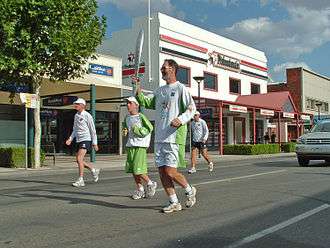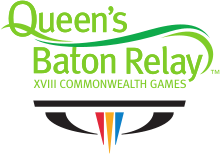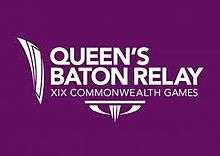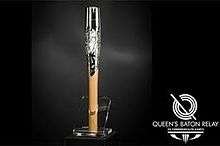Queen's Baton Relay

The Queen's Baton Relay, similar to the Olympic Torch Relay, is a relay around the world held prior to the beginning of the Commonwealth Games. The Baton carries a message from the Head of the Commonwealth, currently Queen Elizabeth II. The Relay traditionally begins at Buckingham Palace in London as a part of the city's Commonwealth Day festivities. The Queen entrusts the baton to the first relay runner. At the Opening Ceremony of the Games, the final relay runner hands the baton back to the Queen or her representative, who reads the message aloud to officially open the Games.[1]
History
The Relay was introduced at the 1958 British Empire and Commonwealth Games in Cardiff, Wales. Up until, and including, the 1994 Games, the Relay only went through England and the host nation. The Relay for the 1998 Games in Kuala Lumpur, Malaysia was the first to travel to other nations of the Commonwealth. The 2002 Commonwealth Games Relay covered over 100,000 kilometres and went through 23 nations.[1]
Editions
Auckland 1990
For the 1990 Commonwealth Games, the baton was a two-piece affair. Each piece went on its own individual relay run in the North and South Islands of New Zealand, only being joined back together in the final week before the Games began.
Victoria 1994
For the 1994 Commonwealth Games, the Baton was fashioned from sterling silver and was engraved with traditional symbols of the creative artists' families and cultures, including a wolf, a raven and an eagle with a frog in its mouth.
Kuala Lumpur 1998
For the 1998 Commonwealth Games, Malaysia placed their own flavour on the Games, with the Queen's Baton being carried into the stadium on an elephant. The baton was presented to Prince Edward by Malaysia's first ever Commonwealth medal winner Koh Eng Tong, a gold medallist in weightlifting in 1950. The Baton design was inspired by a traditional Malay artifact, the 'Gobek', which is a unique cylindrical areca nut-pounder widely used and displayed in Malay homes.
Manchester 2002
For the 2002 Commonwealth Games, the baton had special significance as it marked the Golden Jubilee of Her Majesty The Queen and was designed to symbolise the uniqueness of the individual and the common rhythm of humanity.
Melbourne 2006

| 2006 Commonwealth Games |
|---|
The Melbourne 2006 Queen's Baton Relay was the world's longest, most inclusive relay, travelling more than 180,000 kilometres and visiting all 71 nations that then sent teams to the Commonwealth Games[lower-alpha 1] in one year and a day. The Queen's Baton Relay started, as it traditionally does, at Buckingham Palace and ended in Melbourne, Australia at the Melbourne Cricket Ground. It carried a message from the Queen to the Opening Ceremony of the Commonwealth Games. Fremantle Dockers Captain Matthew Pavlich carried the baton through Fremantle, he received the baton from community nominee and local businessman Peter Taliangis.
The baton contained 71 lights on the front, representing the 71 member nations of the Commonwealth Games Federation. A video camera built into the front of the baton recorded continuously as the baton travelled, and a GPS tracker was fitted, so that the baton's location could be viewed live on the Commonwealth Games Website.
Delhi 2010

2010 Commonwealth Games |
|---|
The relay began as the Baton left Buckingham Palace on 29 October 2009, travelling throughout the 70 nations of the Commonwealth, reaching India on 25 June 2010 by crossing through Wagah from Pakistan.[2] the baton was designed by Michael Foley, a graduate of the National Institute of Design. Made from aluminium twisted into a helix, it was coated with soils from the various regions of India, and held the Queen's message (printed on an 18 carat gold leaf, representing gold's qualities and symbolism of power in India) within a jeweled box.
When the baton relay began at Buckingham Palace, the then-President of India, Pratibha Patil, was present. The Final Baton Runner Sushil Kumar handed over the baton to Prince Charles, who with President Pratibha Patil inaugurated the games.
The baton also incorporated a video camera and microphone, LED lighting (which set its color scheme to match the flag of the nation it was travelling through), and GPS tracking.
Glasgow 2014

2014 Commonwealth Games |
|---|
The Queen's Baton Relay began its 190,000 km journey on 9 October 2013. The baton travelled via 70 nations and territories over 288 days before opening the games on the 23 July 2014. At the ceremony, 32 inspiring volunteers from across Scotland carried the baton around Celtic Park Stadium after being nominated for giving their time to developing the nation's youth through sport. The baton was then passed to Sir Chris Hoy, who delivered it to President of the Commonwealth Games Federation HRH Prince Imran and the Queen who then declared the games open.
BBC Coverage
The BBC provided coverage of the relay.[3] Adventurer Mark Beaumont presented a series of documentaries filmed on the relay for BBC One Scotland, there were also weekly updates for BBC News and a BBC News website and blog written by Mark.
Baton Design

The product design consultancy awarded the contract to the design of the 2014 Queen's Baton is a local Glasgow company called 4c Design.[4] 4c Design wanted the 2014 baton to be true to the original intentions of the first relay and so wanted to focus the design around the Queen's handwritten message. Also rather than using cutting edge electronics, they choose to focus on cutting edge manufacturing. This all culminated in the Queen's message being internally illuminated to hint at the secret within, then surrounded by a titanium lattice framework that was grown using the latest additive manufacturing technology. At the top is a puzzle mechanism[5] that dispenses granite gemstones to each of the Commonwealth nations and territories the baton visits, inviting them to join Glasgow at the Games. The puzzle mechanism also has a second function of keeping the message safely locked away until the opening ceremony, where the second stage of the puzzle will be unveiled. The handle of the Queen's Baton is made of Elm wood which came from the Isle of Cumbrae in Scotland. It was felled by local man David Stevenson in the grounds of the garrison house and the baton is crafted using an old boat building technique called bird mouthing.
Journey of the Baton part 1 - South Asia
On 10 October 2013 the Queen's Baton visited Stirling University (home of the Commonwealth Games Council for Scotland) where the domestic sector route was unveiled. After a reception at Glasgow's city chambers the baton left from Glasgow Airport on an Emirates aircraft en route to India.
The Baton arrived at Indira Gandhi International Airport, New Delhi, at 8.15pm local time on 11 October, after a transit stop in Dubai. The Baton was given a ceremonial reception by top Indian sportspersons and officials, including IOA acting chief Vijay Kumar Malhotra.[6] Mr Malhotra received the Baton from 2014 Glasgow Organising Committee Vice-Chair and Commonwealth Games Federation Honorary Secretary Louise Martin before being handed to the Indian sportspersons present at the reception. Other Indian officials who were present included senior IOA officials G S Mander and S Reghunathan as well as Indian Weightlifting Federation Secretary General Sahdev Yadav. Sportspersons who were present to receive the Baton include discus thrower Krishna Poonia, weightlifter Kutulu Ravi Kumar, shooter Samresh Jung and wrestlers Yogeshwar Dutt, Ravinder Singh and Anil Kumar; all of whom won gold medals in the 2010 Delhi Commonwealth Games.
On 12 October 2013, the Queen's Baton moved to the Taj Mahal entering through the eastern gate.[7] The Queen's Baton returned to New Delhi and the first stop was the India Gate before the British High Commissioner hosted a reception for the Baton in the evening.[8] On the next day UNICEF[9] held a programme for the Queen's Baton at Salwan Public School before it was taken to Qutub Minar by Indian athletes later in the day.[10]
On 14 October the Baton moved to Dhaka in Bangladesh. It was met at the airport by officials from the Bangladesh Olympic Association and Faruk Khan, the Bangladeshi Civil Aviation and Tourism Minister.[11] There was a lot more enthusiasm for the Baton in Bangladesh[12] and there was an actual relay part way to the British High Commission, where a reception was held. On the next day the Baton visited Jatiyo Smriti Soudho and a number of young people from Aparajeyo Bangla (which translates as Invincible Bengal), an NGO supported by UNICEF had turns holding the Baton.[13]
The Baton moved on Pakistan after an unscheduled diversion via Delhi. The first full day in Lahore saw the Baton visit the Minar-e-Pakistan marble tower – a monument commemorating the resolution of Pakistan. There the baton was met by a large group of athletes, all wishing to hold it.[14] There was however controversy concerning the visit of the Baton to Pakistan. The Commonwealth Games Federation recognises the Pakistan Olympic Association whereas the Pakistan Government recognises the Pakistan Sports Board (PSB).[15] After a visit to the Badshahi Mosque where Abdul Ghafoor, a former weightlifter who won a silver medal in the flyweight division at the 1970 Commonwealth Games lifted the Baton,[16] the Baton was placed in the hands of Arif Hasan, and the Pakistan Olympic Association.
The weekend saw the Baton move to its next country Sri Lanka, which it reached via Dubai. Again there was great enthusiasm for the Baton Relay.[17] The baton, which was received by Sri Lankan Olympic Committee officials at the Colombo international airport, was taken to the Independence Square by the former national hurdler Sriyani Kulawansa[18] in a horse-drawn carriage, making a stylish entrance. The Baton was taken to Kandy by a special train, which stopped at Veyangoda, Polgahawela, Rambukkana and Kandugannawa railway stations where special receptions were hosted by communities, including a visit to Pinnawala Elephant Orphanage. The day finished with a reception at the British High Commission.[19]
Journey of the Baton part 10 - North America
- Canada
Final Baton Runners
See also
Notes
- ↑ At that time, the Commonwealth of Nations had 53 members (the current total is 54 after Rwanda's entry in 2009). However, the four Home Nations send separate teams to the Commonwealth Games, as do individual British Crown Dependencies, several British overseas territories, the Australian external territory of Norfolk Island, and two non-sovereign states in free association with New Zealand, the Cook Islands and Niue.
References
- 1 2 "Queen's Baton Relay: The tradition continues...". Melbourne 2006 Commonwealth Games Corporation. Retrieved 15 February 2007.
- ↑ CWG 2010 Queen's baton arrives in India CWG 2010 Queen's baton arrives in India
- ↑ BBC Coverage of the Queen's Baton Relay
- ↑ Designers of the Glasgow 2014 Queen's Baton
- ↑ Design process for the Puzzle Mechanism
- ↑ Queen’s Baton arrives in India, received by IOA officials Archived 16 October 2013 at the Wayback Machine.
- ↑ Rediff sports account of Baton at Taj Mahal
- ↑ QBR showcased at India Gate on 1st day of India stoppage
- ↑ An inspiring morning with children in Delhi, showing such enthusiasm for sports!
- ↑ Queen's Baton Relay at Qutub Minar - Rediff coverage
- ↑ Queen’s Baton Arrives – BD News 24 Archived 16 October 2013 at the Wayback Machine.
- ↑ Relay Recap Day 6
- ↑ Relay Recap Day 7
- ↑ Relay Recap Day 9
- ↑ Pakistan Government boycott Queen's Baton Relay on visit to Lahore – Inside the Games
- ↑ Abdul Ghafoor won a weightlifting medal for Pakistan in Edinburgh's 1970 Games! Today he lifted the Queen's Baton!
- ↑ Sri Lankan youths turn out to welcome the baton!
- ↑ Queen’s Baton arrives in Sri Lanka - Hiru News
- ↑ British High Commissioner to Sri Lanka John Rankin holds up the Queen’s Baton with Sri Lankan athletes – ft.lk
External links
- Official website of 2014 Queen's Baton Relay
- BBC Coverage of 2014 Queen's Baton Relay
- 2014 Queen's Baton Designers
- Official website of 2010 Queen's Baton Relay
- Official website of 2006 Queen's Baton Relay
- Queen's Baton Relay on New Zealand Commonwealth Games website